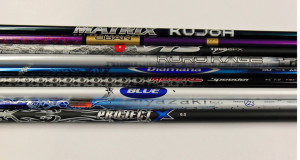 Getting the right shaft in your golf clubs is key to accuracy, distance and consistency. The shaft is the transmission that delivers the energy from the golfer (engine) to the ball. If the shaft is too loose, like as slipping transmission, you will lose distance and control. If the shaft is to stiff or heavy, like a tight transmission on a sports car, you will also find it difficult to control. A proper shaft delivers the longest distance, the tightest accuracy and consistent control.
Getting the right shaft in your golf clubs is key to accuracy, distance and consistency. The shaft is the transmission that delivers the energy from the golfer (engine) to the ball. If the shaft is too loose, like as slipping transmission, you will lose distance and control. If the shaft is to stiff or heavy, like a tight transmission on a sports car, you will also find it difficult to control. A proper shaft delivers the longest distance, the tightest accuracy and consistent control.
An S flex is not Really an S Flex. After testing thousands of golf shafts each year, and testing them prior to assembly, we see a very wide range in flexes of shafts, not only from one manufacturer to another, but from one shaft to another. If you have been to your local pro shop or driving range and tested a few clubs, the first thing you notice is that you seemed to hit an “S” flex more consistently in one manufacturer’s club but an “R” flex better in another. You want to spend your hard earned money on the right equipment, but this inconsistency is driving you crazy. What is going on here?
First of all, every manufacturer like Callaway, Ping, and Taylor Made have shaft companies like Fujikura, Graphite Design and True Temper make shafts specifically for their clubs. These shafts are designed to perform with the clubheads (like the EPIC) to get particular performance characteristics, like higher launch angles, etc. These shafts are also designed for a particular target market, like beginners, better players, etc. Because of this, an R shaft in a EPIC will not feel or hit the same as a Firm flex in a Ping G400 LST. The same holds true for steel iron shafts. A Project X LZ or stock shaft in one club will be stiffer or softer than in another. That is why you may hit one manufacturer’s clubs better in an R flex than an R flex in another.
Why Shafts are Inconsistent
Steel shafts in general are much more consistent than graphite shafts because of the way they are manufactured. The rolling or extruding process of making a steel shaft produces a shaft of more uniformity and consistency. Graphite shafts are made by wrapping multiple thin layers of graphite material around a tapered steel mandrel. This wrapping process produces overlaps that cause thick and thin spots and uneven weight distribution throughout the length of the shaft. One measure of shaft consistency is its frequency, or CPM (cycle per minute) as the shaft is rotated around its axis. Steel shafts are very consistent but graphite shafts can vary as much as two full flexes from shaft to shaft. This is why you can hit your buddy’s driver great on the range, go to the local pro shop and buy the exact same thing, and not hit it out of your shadow!
Spines are Everywhere
For both graphite and steel, but especially for graphite, the stiffest part of the shaft creates a “spine”. This spine can cause you to hook or slice if the shaft is not properly aligned in the clubhead when it is assembled. At TrueFitClubs, we test each shaft on the MCC Shaft Profiling Machine to determine the exact location of the stiffest part of the shaft. We then align this spine so that it is facing the target line of the club at address. By doing this, you will have a shaft that aligns itself perfectly square at impact. No major manufacturer does this in their stock clubs. Most clubs purchased over-the-counter will have a variety of shaft alignments and will perform erratically. Just when you think it’s your swing, you are wrong again..it’s the shaft!
So What Should You Do?
First, by testing your swing on the True Temper Shaft Lab or Mizuno Shaft Optimizer at D’Lance Golf, you will know the optimum shaft flex for your natural swing. Each person has a natural way of swinging the club that produces an optimum shaft flex for both their woods and irons. To hit each club in your bag the farthest and straightest of your ability, each club needs to be matched to your optimum shaft flex. The next step is to have each of your clubs tested on a frequency meter to determine their exact flex. Then, you can see how closely they match your optimum swing. If the shafts are off by as little as a third of a flex, you will notice that your shot dispersion is quite a bit greater than you would like. While we can tell you that you need to have a shaft flex in your woods of low stiff (5.7 Shaft Flex Index), it will be highly unlikely that you can purchase a club off the rack that is that exact flex. By custom building or re-shafting your existing equipment, D’Lance Golf can frequency match your clubs to the EXACT CPM you need prior to building your clubs. Buy your clubs off the rack and you will be lucky to get the consistent, accurate clubs you bargained for. So, don’t waste your hard earned money on the trial and error method of club buying. Call D’Lance Golf at 303-730-2727 today for an appointment to get your swing analyzed and your current clubs profiled. That way you are assured that each club in your bag will perform consistently from swing to swing, day to day, throughout the season.
